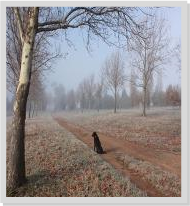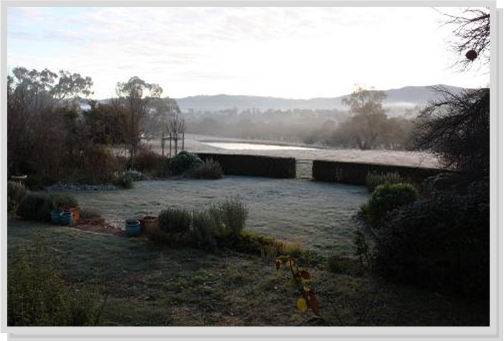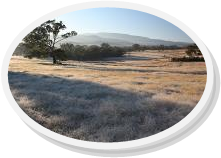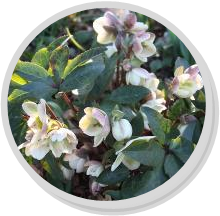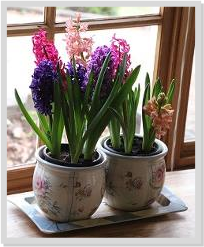
|
Even though itís June and midwinter, the landscape is full of colour. In the morning when Wombat and I are out walking, Wombat scuttling after rabbits, me glowing in the cold, itís blue and silver: the sky duck egg blue, the gums and wattles silvery pewter, the pasture glinting with white frost.
By morning tea everything has turned golden as the sun shines through the last oak leaves hanging on the tree, and across the fallen ones scattered across the lawn.
Then in early evening itís dark red just for a few minutes, as the sinking sun catches the paddocks and the moon emerges above the distant, bush covered hills.
Indoors itís warm and cosy with our ancient Petit Godin heater, and I try to remember to put my white cyclamen into the laundry every night. Cyclamen hate warm rooms and mine would be better off in our bedroom, easily the coldest room in the house, but I love it so much I canít bear to have it anywhere but the kitchen, which is the warmest.
Cyclamen need a pot in a saucer so you can water them from the base, as overhead watering may rot the tubers. Plants like plenty of light but not direct sunlight.
June is when I notice Bill sharpening his various pruning saws. He has already done the ornamental grapes, cutting each vine back to three or four main runners.
This prevents them growing into a vast, labyrinthine tangle which blocks the sun, not only in winter when you need its warmth but also in summer, when you want to enjoy the dappled shade beneath a leafy canopy.
The wisteria is next for the chop. Long canes cut back to two or three spurs when the plant is leafless encourages flowering while preventing the large, scented racemes from being obscured by lush spring growth.
|
|
Wisterias are huge plants, up to 30 metres in the right conditions. They need a strong pergola for support, preferably well away from the house.
They love growing up trees though again only the sturdiest, most stable specimens are strong enough to carry their weight.
June is the time to start planting bare rooted trees and shrubs, including roses. Iím always getting carried away by new plants and then struggling to find room for them. Better to spot a gap in the garden and buy something to fill it, but I never seem to have any gaps.
Last winter, though, I actually discovered an empty space and filled it with a purple leaf elder (Sambucus nigra ĎBlack Laceí). It has done well and loved our unseasonably damp summer.
Its purple flushed, dissected leaves droop in a heavy frost but spring back during the day.
The flat, pale pink flowers are sterile so no shiny, black berries for elderberry wine. You need the common elder, S. nigra, of the English hedgerows for this.
Elder has large, creamy white flowers smelling of honey but unfortunately all parts of the shrub, other than the flowers and fully ripe berries, are poisonous.
The leaves of a varnished gold autumn crocus (Sternbergia lutea) beneath the elder are starting to decay, a reminder to fertilise all my autumn bulbs including colchicums, autumn snowflakes (Leucojum autumnale) and vermilion and yellow Gladiolus natalensis before they vanish underground and from my memory.
Winter is a good time to spread compost on the garden. Barrowing compost is time consuming but I need an empty bay for the autumn leaves, which otherwise go directly onto the garden beds, with organic life to help them break down.
Compost is the best fertiliser going and I never have enough, so I start with the most thickly planted beds that need nourishment the most.
Fionaís Garden column in The Land,† June 2011
|
|
††† Gardening ††† Tips |

